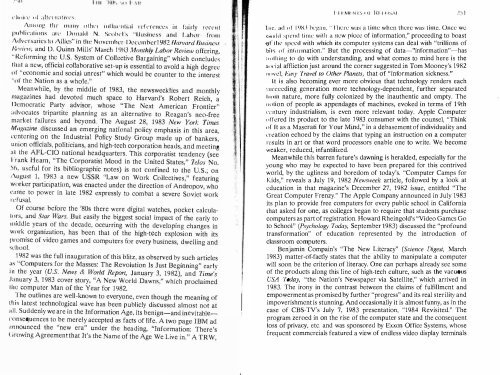CONTENTS - ouroboros ponderosa
CONTENTS - ouroboros ponderosa
CONTENTS - ouroboros ponderosa
Create successful ePaper yourself
Turn your PDF publications into a flip-book with our unique Google optimized e-Paper software.
l'lh)in' tIl ;J!l cl l1:l liv(".,\.<br />
AIllOIlJ-', Ille lIIauy llh('1 illlillcillial refercnces in fairly recellt<br />
puhlicalions an.: l)oll;lld N. SCt lhd 's "Busincss and Lahor- fro m<br />
I\dvnsarics 10 I\lIies" in Ihe Novemher Ikccmber1 982 !/llIv"rd /)".I'in£'.>.I'<br />
:.I, .... inv. anu D. Quinn Mills' March 1'i1l3 Monthly Labor Review offerin/.: ,<br />
Rdormlllg thc U.S. System of Collective Bargaining" which concluu"s<br />
Ihal a new. official collaborative set-up is essential to avoid a high degr" "<br />
of "economic and social unrest" which would be counter to the interest<br />
"of the Nation as a whole."<br />
Meanwhile. by the middle of 1983. the newsweeklies and monthly<br />
magazmes had devoted much space to Harvard's Robert Reich, a<br />
I)cmocratic Party advisor, whose "The Next American Frontier"<br />
OIuvocates tripartite planning as an alternative to Reagan's nea-free<br />
market failures and beyond. The August 28, 1983 New York Times<br />
M"/iuzine discussed an emerging national policy emphasis in this area<br />
'<br />
ce ntering on the Industrial Policy Study Group made up of bankers<br />
union officials, politicians, and high-tech corporation heads, and meetin<br />
al Ihe AFL-CIO national headquarters. This corporatist tcndency (see<br />
hank Hearn, "The Corporatist Mood in the United States," Telos No.<br />
)6 , uscful for its bibliographic notes) is not confineu to the U.S.; on<br />
I\u/.:ust 1, 1983 a new USSR "Law on Work Collectivcs ." featuring<br />
wnrker parllclpallon, was enacted under the direction of Andropov, who<br />
came to power in late 1982 expressly to combat a severe Soviet work<br />
rdusal.<br />
Of course bcfore the '80s thcre were digital watches, pocke t calcula<br />
lors, anu Star Wa rs. But easily the biggest social impact of the early to<br />
Illiddle years of thc decade, occurring with the developing changes in<br />
work organization, has been that of the high-tech explosion with its<br />
promise of video games and computers for every business, dwclling and<br />
school.<br />
1. '182 was the full inauguration of this blitz. as observed by such articles<br />
as "Computers for the Masses: The Revolution Is Just Beginning" early<br />
III the year (U.s. News & World Report, January 3, 1982), and Ii'me's<br />
J anuary 3, ] 983 cover story, "A New World Dawns," which proclaimed<br />
Ihe computer Man of the Year for 1982.<br />
The outlines are w.cll-known to everyone, even though the meaning of<br />
Ih,s latest technological wave has been publicly discussed almost not at<br />
all. Suddenly we are in the Information Age, its benign-and inevitable<br />
I'Onsequences to be merely accepted as facts of life. A two page IBM ad<br />
announced the "new era" under the heading, "Information: There ' s<br />
('rowing Agreement that It's the Name of the Age We Live in." A TRW,<br />
•<br />
•<br />
l-<br />
I<br />
I<br />
,<br />
1 ·.l I ·MI · N I:' III 1






